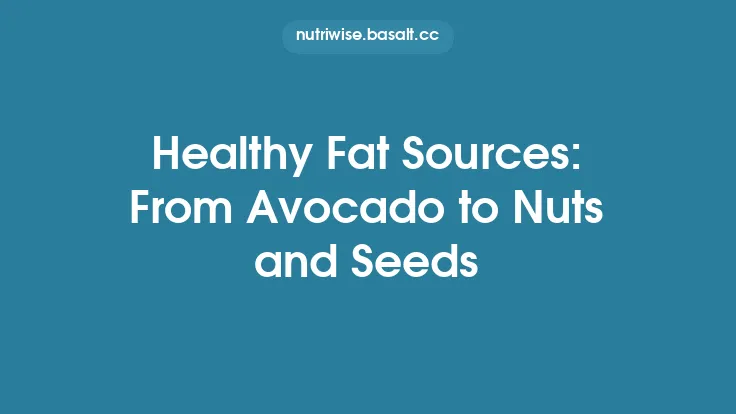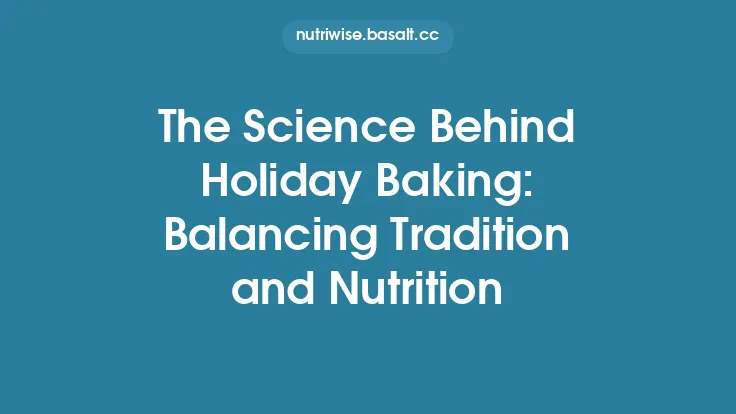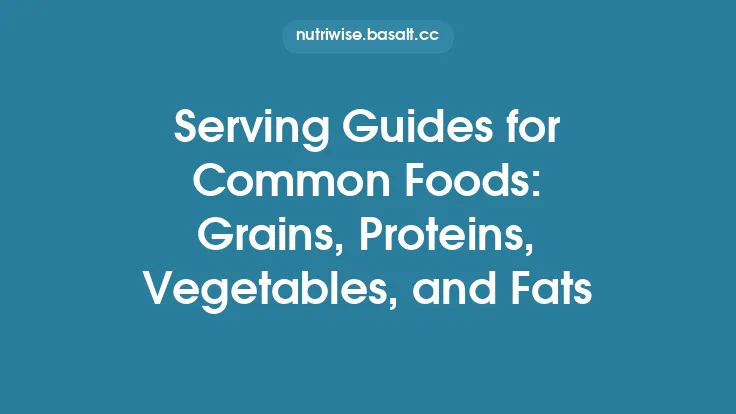When it comes to baking, fat isn’t just a source of richness—it’s a structural player that influences texture, moisture, leavening, and flavor. Swapping out traditional butter for healthier alternatives can boost the nutritional profile of your treats without sacrificing the qualities that make baked goods so satisfying. Below is a comprehensive guide to making informed fat swaps, focusing on avocado, a range of nut oils, and other plant‑based fats that can seamlessly replace butter in a variety of recipes.
Why Fat Matters in Baking
- Texture and Crumb: Fat coats flour particles, limiting gluten development. This creates tender, short‑crusted pastries and a softer crumb in cakes and muffins.
- Moisture Retention: Fat slows water loss during baking, keeping the interior of baked goods moist.
- Aeration: When creamed with sugar, solid fats trap air bubbles that expand in the oven, giving rise to light, fluffy textures.
- Flavor Carrier: Fat dissolves and distributes flavor compounds, enhancing the overall taste experience.
Understanding these roles helps you anticipate how a new fat will behave and what adjustments may be needed.
Understanding Butter’s Role
Butter is a semi‑solid emulsion composed of roughly 80 % milk fat, 15–18 % water, and a small amount of milk solids. Its unique characteristics stem from:
| Property | Typical Value (Butter) | Baking Impact |
|---|---|---|
| Melting Point | 32–35 °C (90–95 °F) | Provides a firm structure at room temperature, yet melts quickly in the oven for steam generation. |
| Water Content | 15–18 % | Contributes to steam, aiding leavening and creating flaky layers in pastries. |
| Flavor | Rich, dairy‑derived | Adds characteristic buttery notes that many recipes rely on. |
When substituting, consider both the fat content and the presence (or absence) of water, as this will affect dough consistency and final texture.
Avocado as a Butter Substitute
Nutritional Profile
- Total Fat: ~15 g per 100 g (mostly monounsaturated oleic acid)
- Water: ~73 g per 100 g
- Calories: ~160 kcal per 100 g (lower than butter’s ~720 kcal per 100 g)
Functional Characteristics
- Texture: When mashed, avocado yields a smooth, creamy paste that behaves like a soft solid at room temperature.
- Moisture Contribution: The high water content adds extra moisture, which can be advantageous in brownies, muffins, and quick breads but may require a slight reduction of other liquids.
- Flavor: Mild, buttery undertones that complement sweet and savory baked goods without overpowering them.
How to Use It
- Ratio: Replace butter 1:1 by weight (e.g., 100 g butter → 100 g mashed avocado). Because avocado is less dense, you may need to measure by weight rather than volume for accuracy.
- Adjust Liquids: Reduce added liquids (milk, water, or fruit puree) by about 10–15 % to compensate for avocado’s water.
- Best Applications: Chocolate brownies, banana bread, muffins, and dense cakes where extra moisture is welcome.
Technical Tip
If you desire a firmer crumb (e.g., in cookies), chill the dough after mixing. The avocado will solidify at lower temperatures, mimicking butter’s behavior during baking.
Nut Oils: Almond, Walnut, Hazelnut, and More
Overview of Fat Composition
| Oil | Predominant Fatty Acids | Smoke Point | Typical Use |
|---|---|---|---|
| Almond Oil | ~70 % monounsaturated (oleic) | 210 °C (410 °F) | Light‑flavored cakes, muffins |
| Walnut Oil | ~60 % polyunsaturated (linoleic) | 160 °C (320 °F) | Rich, nutty breads, brownies |
| Hazelnut Oil | ~80 % monounsaturated | 210 °C (410 °F) | Chocolate‑based desserts, cookies |
| Macadamia Oil | ~80 % monounsaturated | 210 °C (410 °F) | Delicate pastries, shortbread |
Functional Differences from Butter
- State: Nut oils are liquid at room temperature, lacking the water component of butter. This means they won’t create the same steam‑driven lift in laminated doughs or flaky pastries.
- Flavor: Each oil imparts a distinct nutty aroma; use sparingly in recipes where the flavor should not dominate.
- Shelf Stability: High polyunsaturated content (especially in walnut oil) can oxidize faster; store in a dark, cool place and consider using within a few weeks.
Substitution Guidelines
- Direct Replacement: For recipes where butter’s primary role is moisture and richness (e.g., quick breads, muffins), replace butter with nut oil at a 1:1 volume ratio. Because butter contains ~15 % water, you may need to add a teaspoon of extra liquid per cup of oil to maintain the same overall moisture balance.
- Emulsion Creation: In cakes that rely on creaming, combine nut oil with a small amount of solid fat (e.g., a tablespoon of coconut oil) to mimic the aeration effect.
- Baking Temperature: Since oils conduct heat more efficiently, monitor browning closely; you may need to lower oven temperature by 10–15 °C (20–30 °F) to prevent over‑browning.
Ideal Applications
- Almond Oil: Light, airy cakes, vanilla cupcakes, and fruit‑filled pastries.
- Walnut Oil: Dark chocolate brownies, whole‑grain breads (where the nutty note complements the grain).
- Hazelnut Oil: Chocolate chip cookies, hazelnut‑flavored biscotti, and layered desserts.
Coconut Oil and Its Unique Properties
Composition
- Saturated Fat: ~90 % (mostly medium‑chain triglycerides)
- Melting Point: 24 °C (76 °F) – solid at cooler room temperatures, liquid when warm.
Baking Implications
- Solid‑When‑Cold: Behaves similarly to butter in creaming, allowing for air incorporation.
- No Water: Like nut oils, coconut oil lacks water, so recipes that depend on butter’s steam may need a splash of milk or water.
- Flavor: Distinct coconut aroma; refined (neutral) coconut oil can be used when a neutral profile is desired.
Substitution Strategy
- 1:1 by Weight: Replace butter with an equal weight of solid coconut oil for cookies, pie crusts, and shortbreads.
- Adjust Liquids: Add 1–2 Tbsp of liquid per cup of coconut oil if the dough feels dry.
- Temperature Control: Keep the oil solid when creaming; if it softens, refrigerate briefly before use.
Comparing Fat Profiles and Nutritional Impacts
| Fat Source | Calories (per 100 g) | Saturated % | Monounsaturated % | Polyunsaturated % | Key Micronutrients |
|---|---|---|---|---|---|
| Butter | 720 | 51 | 21 | 3 | Vitamin A, D, K2 |
| Avocado (mashed) | 160 | 15 | 70 | 10 | Potassium, Vitamin E |
| Almond Oil | 884 | 9 | 70 | 20 | Vitamin E |
| Walnut Oil | 884 | 9 | 15 | 70 | Omega‑3 (ALA) |
| Coconut Oil | 862 | 87 | 6 | 2 | Small amounts of iron |
Choosing a healthier fat often means reducing saturated fat and increasing monounsaturated or polyunsaturated fats, which are linked to improved lipid profiles and reduced cardiovascular risk.
Practical Tips for Substituting Fats
- Measure by Weight: Fat density varies; weighing ensures consistency.
- Mind the Water Content: Butter’s water contributes to steam. When using a dry fat (oil, avocado), add a modest amount of liquid (milk, water, or fruit puree) to preserve lift.
- Temperature Matters: Solid fats should be at the same temperature as the original butter (softened but not melted) for creaming.
- Flavor Pairing: Match the fat’s flavor to the recipe—use neutral oils for delicate cakes, and nutty oils for chocolate or spice‑laden treats.
- Batch Testing: Start with a small test batch when trying a new fat to gauge texture and flavor before scaling up.
Adjusting Recipes for Consistency and Flavor
- Cookies: If a recipe calls for 1 cup butter, try ¾ cup avocado + ¼ cup almond oil. This maintains spread while adding moisture and a subtle nutty note.
- Cakes: Replace 1 cup butter with ¾ cup walnut oil + ¼ cup coconut oil (solid). Cream the coconut oil with sugar, then whisk in the walnut oil to achieve aeration.
- Pie Crusts: Use ½ cup solid coconut oil + ½ cup cold avocado chunks. Pulse in a food processor until pea‑sized crumbs form, then add ice water as usual.
Baking Tests and Troubleshooting
| Symptom | Likely Cause | Remedy |
|---|---|---|
| Dry, crumbly texture | Too much dry fat (oil) without added liquid | Increase milk/water by 1–2 Tbsp per cup of oil |
| Excess spread in cookies | Fat too soft (avocado at warm room temp) | Chill dough 30 min before baking |
| Dense, heavy crumb | Insufficient aeration due to liquid fat | Incorporate a small amount of solid fat (coconut oil) for creaming |
| Bitter or off‑flavor | Oxidized nut oil | Use fresh oil, store in dark glass, limit to 4–6 weeks |
| Uneven browning | High polyunsaturated oil oxidizing quickly | Lower oven temperature 10–15 °C and extend bake time slightly |
Health Benefits of Choosing Better Fats
- Heart Health: Monounsaturated fats (found in avocado and almond oil) help lower LDL cholesterol while maintaining HDL levels.
- Anti‑Inflammatory Effects: Omega‑3‑rich walnut oil provides precursors for anti‑inflammatory eicosanoids.
- Improved Satiety: The higher fiber content of avocado (when used as a puree) can increase feelings of fullness, potentially aiding weight management.
- Nutrient Density: Avocado and nut oils contribute vitamins (E, K) and minerals (potassium, magnesium) absent in butter.
By thoughtfully selecting and applying these healthier fats, you can enjoy baked goods that are not only delicious but also aligned with a nutrition‑focused lifestyle.
Final Thoughts
Swapping butter for avocado, nut oils, or coconut oil is more than a simple ingredient change—it’s a strategic adjustment that influences texture, flavor, and nutritional quality. Understanding each fat’s composition, melting behavior, and moisture contribution empowers you to tailor recipes with confidence. Whether you’re aiming for a buttery crumb, a moist brownie, or a light, airy cake, the right fat swap can deliver the results you crave while supporting a healthier diet. Happy baking!





